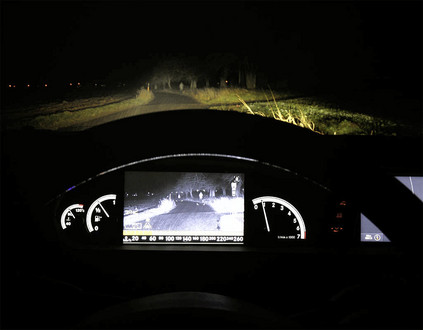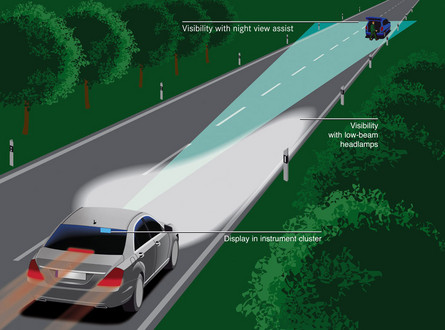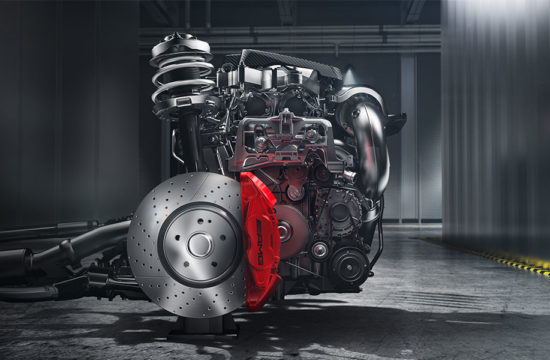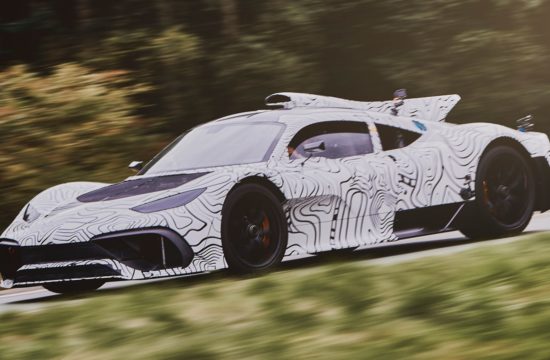
Mercedes has upgraded the amazing Active Night View Assist Plus and added a new feature that enhances the safety for pedestrians. It’s a spotlight function that detects pedestrians on the road and highlight them on the display in the instrument cluster. This system also specifically direct light on the spotted object, so not only the driver has a better view, the pedestrian too becomes aware of the approaching vehicle.
The new spotlight function will be included as a standard feature of the Active Night View Assist Plus in a luxury class Mercedes model from the summer of 2011. With the the new spotlight function for the Active Night View Assist Plus, Mercedes-Benz is for the first time presenting an active light system which provides a completely new level of safety at night.

If the night vision camera detects people on or near the road, they are automatically flashed with the spotlight function to alert the driver to the potential danger. As a positive side effect, pedestrians are also alerted to the approaching vehicle. Studies have confirmed that pedestrians do actually become aware of the spotlight function. Other road users are not dazzled as illumination does not occur if other road users who happen to be travelling in front or approaching in the opposite direction are located near the pedestrian.

How the spotlight function actually works
Caution, pedestrian on the road!
The Night View Assist Plus with new spotlight function is a complex combination of a variety of technical functions. Infrared headlamps, night vision camera, multipurpose camera, spotlight headlamps, instrument cluster display and headlamp switch are all coordinated by several control units using complex software.
This is how the innovative safety feature works in detail: the spotlight function is enabled when the driver switches on Adaptive Highbeam Assist as normal (by turning the rotary light switch to the “Auto” position and pushing the steering-column stalk forward into the main beam position) and activates Active Night View Assist Plus by pressing the adjacent button. The spotlight function is then enabled at speeds above 45 km/h. A corresponding icon in the night vision image notifies the driver that the spotlight function is switched on/active. At speeds below 40 km/h, the spotlight function is automatically disabled. The driver can also disable the function at will, by moving the steering-column stalk from the main beam position into the centre, neutral position (the usual procedure for dimming the lights).
The spotlight function uses infrared technology to detect pedestrians at a range of up to 80 metres: two separate light sources in the headlamps illuminate the road with invisible, non-dazzling infrared light. A windscreen-mounted camera designed to pick up precisely this type of light records what happens in front of the car. The captured image is sent to a display in the instrument cluster. The clear, needle-sharp image that appears here shows the scene in front of the vehicle, allowing the driver to see pedestrians, cyclists or obstacles on the road at an early stage. As soon as the system detects any pedestrians in front of the car, they are highlighted in the display by the Active Night View Assist Plus. A second camera, also used as a so-called multipurpose camera by the Speed Limit Assist and Lane Keeping Assist, detects whether the vehicle is being driven at night. It also records the position of other road users travelling in front or approaching from the opposite direction. All of this information is used by the electronic control unit to decide whether a detected pedestrian is to be flashed with the spotlight function as a warning.
For variable light distribution, a groove cut into the profile of the headlamps helps to create a controllable light source, the spotlight. Outside of built-up areas, pedestrians are flashed with the spotlight function up to four times at night, provided they are located within the light cone. If the Adaptive Highbeam Assist has been switched to dipped beam, the pedestrian is flashed with the spotlight function beyond the area of the dipped beam. If on the other hand main beam is activated, this remains on in the left-hand headlamp, while the pedestrian is flashed with the right-hand headlamp. The flashing headlamp then remains dipped for five seconds in order to avoid dazzling the pedestrian during this time.
It is not possible for other road users to be dazzled, since illumination does not occur when other vehicles which are travelling in front or approaching from the opposite direction are located in the same direction as the pedestrian. In addition, the driver can also disable the spotlight function at any time should he so wish using the steering column stalk.
If the pedestrian should disappear from the camera image, for example because the vehicle has already passed him by or he has moved away from the edge of the road, the headlamp returns to full beam again before the five-second period expires, provided that the conditions imposed by the Adaptive Highbeam Assist have been met. This helps to ensure that the driver once again has access to the full main beam function, and therefore the best road illumination, as quickly as possible.








